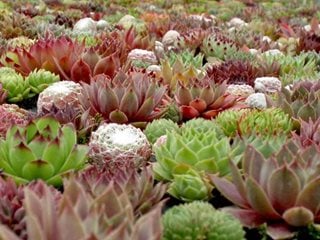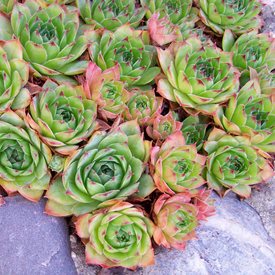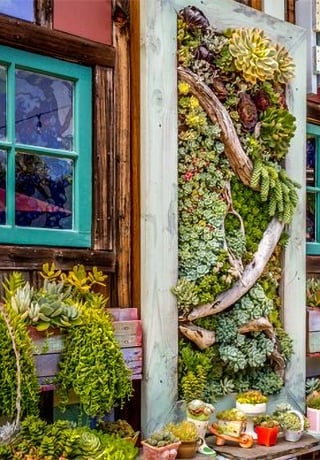A GUIDE TO GROWING HENS AND CHICKS (SEMPERVIVUM)
Add character to your home and landscape with these delightful succulent plants
Though hens and chicks have been cultivated for centuries, they have enjoyed a resurgence in popularity as gardeners look for easy-care and waterwise plants. Also known as common houseleek, these charming groundcover succulents are especially versatile for small urban spaces, adding color and texture to beds and containers.
Sempervivum means “always alive,” referring to the evergreen leaves and the ability of the mother plant (the hen) to produce offspring (the chicks). These hardy perennials need little maintenance once established, making them well-suited for those with busy lifestyles.
On this page: Basics | How to Grow | Care and Maintenance | Pictures | Design Ideas
On this page:
- BASICS
- HOW TO PLANT HENS & CHICKS
- HENS & CHICKS CARE AND MAINTENANCE
- HENS & CHICKS PICTURES
- DESIGN IDEAS
BASICS
Botanical name:
Sempervivum spp.
Common names:
Hens and chicks, common houseleek
Zones:
4-10, or grown as a houseplant
Exposure:
At least 6 hours of full sun. Provide afternoon shade in hotter climates.
Foliage:
Fleshy leaves with pointy tips form a symmetrical rosette shape. Colors occur in shades of green, pink, blue, grey, purple, orange, burgundy, and bicolors.
Flowers:
The mother rosette (the hen) blooms bell-shaped flowers on long stems in summer. Once a hen blooms, it sets seed and dies. The individual rosette should be removed, leaving the chicks behind to fill in the space. Flowers occur in sunset hues of yellow, coral, pink, and orange. Blooms will be scant when grown indoors.
Habit and size:
Low mounding habit with horizontal offsets. Individual rosettes can grow 1 to 4 inches tall and 2 to 12 inches in diameter. Offsets may reach 14 to 24 inches tall, with clumps of rosettes spreading as much as 24 to 36 inches wide, depending on the variety.
Toxicity:
Hens and chicks succulents are non-toxic to pets and children, though mild stomach upset can occur in pets when any plant is ingested.
Are sempervivum deer resistant?
Hens and chicks are generally deer resistant.
HOW TO PLANT HENS & CHICKS

Sempervivum can handle freezing temperatures, and snow can actually insulate them from cold air and wind.
Photo by: Maria Nikiforova / Shutterstock
When to plant:
Hens and chicks can be planted almost anytime. However, avoid planting in freezing temperatures or extreme heat, which can cause plant shock.
Where to plant:
Plant in a site that receives at least 6 hours of full sun. In hotter climates, provide afternoon shade. Too much shade will result in poor coloring and spindly growth.
How to plant:
Dig a hole just big enough to accommodate the roots. Place plant in the hole and spread out roots. Cover with soil up to the base of the plant and tamp soil down gently. Take care not to plant too deep. Water lightly and provide regular water until established. Place a thin layer of gravel around the base to help prevent rot.
How to grow hens and chicks in containers:
Sempervivum have a shallow root system, making them suited to small pots and shallow bowls. Make sure containers have adequate drainage. Plant in a potting mix formulated for succulents and cactus. When soil 2 inches down feels dry, water until you see liquid running out of the bottom of the pot.
Plant spacing:
Space plants 6 to 12 inches apart.
Growing sempervivum indoors:
Plant in a potting mix formulated for succulents and cactus. Place in a window that receives as much bright direct light as possible. Plants may need supplemental artificial lighting and may lose some coloring due to lack of bright sunlight. Allow plants to completely dry out between waterings and reduce watering to once a month in winter.
How to propagate hens and chicks:
- From division: The easiest way to propagate hens and chicks is through division. Offsets, known as “chicks” can be separated from the mother plant at any time. Snip the root that runs between the mother plant and chick and transplant to a new location.
- From seed: Start seeds in spring or fall. Fill trays or pots with gritty soil such as cactus mix and sprinkle seed on top. Keep evenly moist until germination (up to 5 weeks). Apply a mulch of fine gravel to protect seedlings and retain moisture. Transplant when seedlings are 1 inch across, after gradually acclimating to outdoor light and temperature. Seeds can also be broadcast into a rock garden or other sunny site.
HENS & CHICKS PLANT CARE

Photo by: Kathy Piper / Shutterstock
Pruning:
Trim off brown, yellow or damaged leaves as needed.
Soil type:
Plants grow best in lean, sandy, well-draining soil, along with a neutral soil pH between 6.5 and 7.5. Amend heavier soils by adding gravel, sand, pumice or perlite.
Watering:
Hens and chicks succulents prefer dry conditions and need little supplemental water. In regions with prolonged dry spells, water every 10 to 14 days, providing more water during extreme heat. Allow soil to dry out completely between waterings. Reduce or cease watering in fall when plants enter dormancy.
Fertilizing:
Hens and chicks need little or no supplemental fertilizer. If desired, apply a slow-release granular fertilizer in spring. For outdoor containers and indoor houseplants, feed with a balanced liquid fertilizer at 1/4 strength every week or two during their growing season of spring and summer. Ceasing fertilizing in fall and winter.
Pests and diseases:
When grown in the right conditions, hens and chicks have few pest or disease issues. Plants can develop crown or root rot in wet soils. Too much moisture can cause rust, a fungal disease. Pests include mealybugs or aphids, which are more likely to occur on indoor plants.
Elongated or misshapen rosettes:
A genetic mutation called fasciation can cause rosettes to become elongated or misshapen. Though it looks odd, it’s not harmful to the plant. Some varieties are more susceptible than others, and this mutation is relatively rare. Cut out affected rosettes, or leave to enjoy the novelty.
HENS & CHICKS VARIETIES
Hens and chicks lookalikes:
Plants that look similar include Echeveria, Mexican ghost plant (Graptopetalum), Graptoveria, Haworthia, and Aeonium. Learn more about how to tell these lookalike plants apart.
DESIGN IDEAS

Living centerpiece for outdoor table. Designer: Debbie Brooks. Photo by: Janet Loughrey.
There are many ways to use hens and chicks in the landscape. Here’s how:
For borders and landscapes: Use as a groundcover at the front of a waterwise border, plant in a curbside strip or rock garden.
For slopes and hillsides: Mass along a slope where the rosettes can be enjoyed up close, or allow to cascade over a rock wall.
For containers: Plant hens and chicks by themselves in containers or with other drought-tolerant plants with similar needs.
Other ideas:
- Plant in cracks and crevices of a rock wall to soften the rough facade.
- Create a vertical wall using hens and chicks as well as other succulents for an intriguing mosaic of color. (See a succulent wall in this California garden.)
- Plant hens and chicks between stepping stones for a lush looking pathway.
- Make unique container arrangements using hypertufa troughs, strawberry planters, tea cups, old shoes, figurine planters, shallow bowls, or an old birdbath.
- Create a living centerpiece for an outdoor patio table using hens and chicks planted in a sleek rectangular trough planter or ceramic bowl.
- Add hens and chicks to a living wreath and display on a front door or prominent place inside. (See how in this video from Garden Answer.)
- Use hens and chicks as a ground cover in a sunny area that won’t receive foot traffic.
RELATED:
Succulents & Succulent Garden Design
Succulent Care
Types of Succulents




